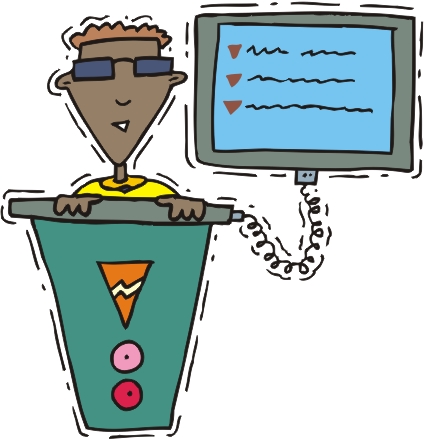
 |
||||||||
Il motoNella prima lezione del laboratorio abbiamo parlato del moto. Il professore ci ha mostrato uno strumento, il sensore di movimento, per misurare il tempo, la velocità e la distanza. Poi abbiamo anche fatto alcuni esperimenti in giardino. C' era un percorso delimitato da due coni e diviso in quattro parti. Alcuni di noi percorrevano questo percorso fermandosi ad ogni cono o aumentando la velocità ad ogni cono. Divisi in gruppi, poi, con un cronometro, dovevamo misurare il tempo che la persona impiegava a percorrere il percorso. Tornati in classe abbiamo inserito questi dati in una tabella che era divisa in tempo, velocità e distanza. Dopo di questo abbiamo fatto la media di ognuna delle tabelle. Dopo siamo andati nel laboratorio di scienze. Qui abbiamo fatto alcuni esperimenti con il sensore di movimento collegato al computer. Negli esperimenti noi, dovevamo allontanarci o avvicinarsi, oppure lanciare una palla o far correre una machina telecomandata che però non riusciva ad andare dritta e il sensore non riusciva a seguire il suo movimento. Il professore ci ha anche spiegato come si legge un grafico. Nell' ultima lezione abbiamo parlato dei sistemi di riferimento. Il sistema di riferimento ci permette di capire se un oggetto si muove o è fermo. Inoltre ci consente di capire quale direzione prende l' oggetto o la persona. Ad esempio un sistema di riferimento è il sensore che ci permette di capire se l' oggetto si muove. Il prima e il dopo si definisce con una regola creata da Reichenbach. Questa regola ci permette di capire se un avvenimento viene prima o dopo e di stabilire un ordine preciso di tutti gli avvenimenti; cioè di fare un ordine di tempo.Reichenbach ha anche detto quando una situazione e reversibile o irreversibile. Un avvenimento è irreversibile quando non si può fare l' inverso di questa cosa. Per esempio quando mescoli la panna con la cioccolata, dopo non puoi più separare questa due cose. Perciò questa azione è irreversibile. Per utilizzare nello stesso esperimento due orologi bisogna, ad esempio, lanciare una palla al di la di un muro. Così è impossibile usare un orologio solo, perchè il bambino che lancia la palla non può vedere quando cade la palla. Potrbbe provare a sentire il rumore, però non è detto che riesca a sentirlo. Perciò ci deve essere un altro bambino al di la del muro, anche lui con un orlogio( sincronizzato con l' altro orologio). Così si può cronometrare quanto tempo ci mette la palla a toccare a terra dall' altra parte del muro.
|
The motion
Then also we have made some experiments in garden. There was a distance delimited from two cones and divided in four parts. Some of us covered this distance stopping themselves to every cone or increasing the speed to every cone. Divided in groups, then, with a chronometer, we had to measure the time that the person employed to cover the distance. When we came back in class we inserted these data in a table that was divided in time, speed and distance. After we made the average of every kind of data. In the laboratory of science: here we made some experiments with the sensor, connected to the computer. In these experiments we had to go away or to approach ourselves, or to launch a ball or to move a remote control car but we had some problems with these objects. The teacher explained us like to read a diagram Distance - time). In the next lesson we have spoken about a reference systems. The reference system allows us to understand if an object moves or is still. Moreover it allows us to understand which direction the object or the person takes. An example of a reference system is the sensor that allows us to understand if the object moves. Before and after it is defined with a rule writed by Reichenbach. This rule allows us to understand if an event comes before or after an other and to establish a precise order of all the events. Reichenbach said also when a reversible or irreversible situation exists. An event is irreversible when the inverse of this thing cannot be made. When you mix the cream with the chocolate, after you cannot separate these two things. Therefore this action is irreversible. Another problem: how is it possible to use two clocks in the same experiment? For example, launch a ball beyond a wall. It is impossible to use a single clock, because the child, who throws the ball, cannot see when the ball falls. He could try to feel the noise, but it is not exact. Therefore we need another child beyond the wall,
but his clock have to synchronize with the other clock.
So we can time how time
the ball ttakes to touch the earth beyond the
wall. |
|
 |
||